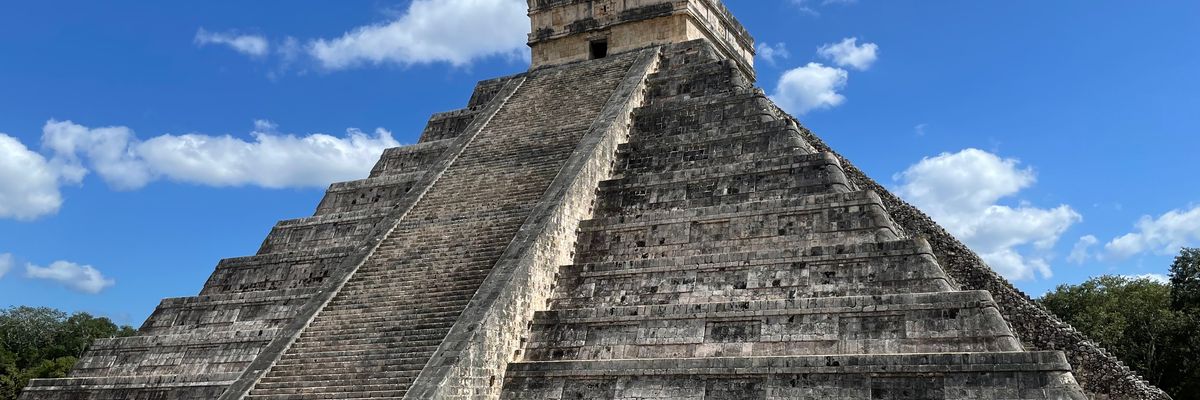
If you ever looked at one of those "what house plant are you according to your zodiac sign" articles, then you're one of us. And given that astrology dates back to at least the 14th century, it's not a new interest, but it's continued to gain more visibility in mainstream media.
The 12 zodiac signs that most of us know come from ancient civilizations. The first celestial coordinate system dates back to Babylonia in the first millennium B.C. Towards the end of the 5th century, Babylonian astronomers divided the ecliptic, the plane of earth's orbit around the sun, into the 12 zodiac sign system we know today.
However, in Mesoamerica, ancient civilizations had a different way of doing things. You've most likely heard of or seen the famous Mayan calendar, but unlike the zodiac system, Mayan astrology is based on yearly calculations according to their calendar, not the constellations of stars and planets. It's relatively common knowledge that these ancient civilizations were forward-thinking and incredibly advanced (don't let post-colonization tales tell you otherwise). Mayans were one of the most dominant Mesoamerican civilizations.
Their astrology system was just as sophisticated. An intro to Mayan Astrology can't get close to delving into the intricacies of the Mayan astrological system which includes day signs, the Mayan year, the trecena, galactic tone, lords of the night, and the planet Venus. Each complements the other and when combined, gives the person a comprehensive understanding of who they are at their core.
What is a Mayan Day Sign?
Mayan day signs are assigned to 20-day periods that cycle 13 times. The 20-day periods make up the 260-day Mayan year. The Mayans associated each 20-day period with a sign, and the system associates days with parts of the world. The signs represent who a person is at their core, and their signs are dependent on birthdate, birth time, and birth location. For example, "day signs can indicate our life purpose and enlighten us to our talents but also our weak spots."
My Mayan Sign has a handy calculator that can be used to determine not just your day sign but also the rest of the supporting elements that provide the overall picture of your core essence.
Once you have determined your day sign, you can see what fundamental aspects are revealed. The list below briefly describes each day sign.
The Crocodile: Represents new beginnings and leadership. This sign is also creative, energetic, and protective.
Wind: Symbolizes communication and intelligence, in addition to a person who tends to be smart, lively, and flexible.
House: Represents optimism and hard work and someone who is loyal, faithful, and patient.
Lizard: Represents freedom and entertainment. Lizar's strengths include being passionate, energetic, and dynamic.
Serpent: Represents intuition and attractiveness. Also includes charisma, empathy, and thoughtfulness.
Death: Represents a strong connection to the spiritual world. While death might sounds scary, these people tend to be practical, generous, and helpful.
Deer: Represents strength and protectiveness. Deer are also innovative and care about the aesthetic.
Rabbit: Represents playfulness and high energy. Rabbits tend to be bright, playful, and lovely.
Water: Represents kindness and being altruistic. Also includes being imaginative, scrupulous, and sincere.
Dog: Represents curiosity and adventure. It's probably no surprise that dogs also tend to be helpful, loyal, and trustworthy.
Monkey: Represents artistic talent. Also funny, chatty, and bright.
Grass: Represents sensitivity and emotions. This sign is also rigorous, adaptable, and regardful.
Reed: Represents confidence and easy problem solving. The reed is supportive, wise, and determined.
Jaguar: Represents charm and friendliness as well as mystery. Also intuitive, clever, and sophisticated.
Eagle: Represents freedom and new experiences. The eagle is independent, autonomous, and tends to be a perfectionist.
Vulture: Represents seriousness and patience, but also knowledgeable, wise, and challenging.
Earth: Represents intelligence and innovation. The earth is practical, philosophical, and affable.
Flint: Represents courage and strength. Positive traits for flint are logic, accommodating, and helpful.
Rain: Represents youth and friendliness. Also a sense of healing, spirituality, and friendliness.
Flower: Represents romance and dreaminess. In addition, affectionate, loving, and creative.
Want to know know more? Check out the calculator or click any of the links above. You will probably be amazed at the results and how accurate you'll find that they match not only your personality but also your Western zodiac sign's characteristics.
- Mayan Astrology: What are Galactic Numbers? ›
- Mesoamerica: More than the Aztec Calendar and Mayan Astrology ›
- Understanding Astrology: Learn These 10 Things First ›


 No More Stolen Sisters: A Human Rights Response to Missing and Murdered Indigenous Women. Source:
No More Stolen Sisters: A Human Rights Response to Missing and Murdered Indigenous Women. Source:  The mother of missing 5-year-old Dulce María Alavez, who disappeared in 2019, expressed concerns that many in the local Latino community are afraid to offer tips for fear of deportation. Photo Source:
The mother of missing 5-year-old Dulce María Alavez, who disappeared in 2019, expressed concerns that many in the local Latino community are afraid to offer tips for fear of deportation. Photo Source: 






